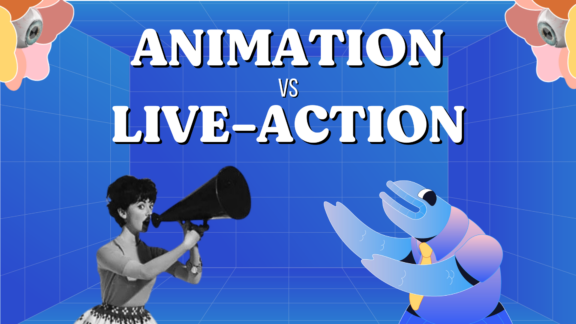- All
- 3D
- Animation
- AWS Activate
- B2B
- B2C
- Bit of Both
- Blog
- Cisco
- DB Culture
- Education
- Emmy® Award Winning
- Entertainment
- Explainer LP
- Featured
- Finance
- Fitness
- Healthcare
- HIMSS
- InBound19
- Live Action
- Live Action LP
- Manufacturing
- Marketing
- Motion Graphics LP
- Software + Tech
- The Drip
- Uncategorized
- Video Marketing
- What We Do Bit Of Both
- What We Do Live Action
The Mad Career of George Miller
September 1, 2022

This past weekend saw the release of Three Thousand Years of Longing, the newest film from George Miller. So today we’re going to step away from our usual blog posts and, like a little pig exploring a wild hodgepodge of a city, we’ll be exploring the eclectic career of a great, unsung director. Get ready for bombastic action, cranked up camera moves, and just sheer audacity.
Mad Max
Prior to making the first Mad Max, George Miller was working as a doctor in Sydney, Australia. He would meet his producing partner, Byron Kennedy, at a summer film school and they started making short films together. The two would form their own production company, Kennedy Miller Productions (now Kennedy Miller Mitchell).
The pair worked to independently finance Mad Max through investors and their own money, Kennedy even driving Miller around to perform emergency medical calls to help raise funds. They’d end up raising around $400,000 for this little ozploitation movie about a cop fighting an evil gang as society starts to crumble in the not too distant future. While now it feels like an outlier from the rest of the franchise, the Miller style and stunt-fueled car chases are all on display. The film became such a hit that for a long time, it held the world record for most profitable film based on its budget. The main place it didn’t catch on was in the US; held back by a poor dub (yes, it was actually dubbed because distributors were worried Americans wouldn’t understand the Australian accents) and Mel Gibson’s lack of star power (simpler times indeed).
But that doesn’t mean George Miller didn’t catch the attention of Hollywood. He would try to get a project off the ground in the states next, but when it failed, he decided to go back to Australia and make Mad Max 2. Because the first one went so unnoticed in the state, it was called The Road Warrior here.
With the first one, he’s admitted to unwittingly making a hero’s journey and was surprised at the way different countries reacted to it, likening it to samurai films or westerns. This would lead him to discovering Joseph Campbell and fully leaning into the mythical hero figure. So he took everything he learned from the first Mad Max and applied it to the sequel, making it bigger, better, and more insane. Only this time, what if the world is fully gone and all the villains looked like they just left an S&M club? And what if he leaned even more into the idea of a silent film with sound? So he crafts the story of the lone wanderer in the wastelands who stumbles into a battle between good and evil over the fuel supply and decides to tell as much as he can through the action. What comes of all this is one of the greatest and most influential action films ever made, ending with a climactic 15 minute car chase.
What do you even do after that?
Well, after working on a few Australian mini-series and directing the best segment of the troubled anthology, Twilight Zone: The Movie, you go back for thirds. Sadly, during pre-production of Mad Max: Beyond Thunderdome, Bryon Kennedy tragically passed away in a helicopter accident, leaving Miller to debate on even doing the film. He would ultimately opt to bring in his friend George Ogilvie to co-direct the film with him. Max, still wandering, finds himself in Bartertown and is enlisted in the struggle between Tina Turner and Master Blaster. Also there’s a tribe of children that are essentially the Lost Boys. This one gets weird and feels like Mad Max through the lens of Amblin or Return of the Jedi. While the concept of the “Thunderdome” and “Two men enter, one man leaves” might be what permeated the culture most from these first three films and there’s still some incredible action sequences, it’s generally considered the worst of the franchise. But hey, even the worst of the Max Mad films is still pretty damn good.
Georgie Goes to Hollywood
Like we mentioned earlier between the second and third Mad Max films, Miller directed a segment of the Steven Spielberg produced (and partially directed) Twilight Zone: The Movie, a more traditional Hollywood production. At the time, he hadn’t realized quite how much power Spielberg had and how that left Miller to pretty much have control over directing his segment. So when he decides to make The Witches of Eastwick, he’s woken up to the harsh reality of the studio system that, as the lead of Witches Jack Nicholson put it “mistake(s) kindness for weakness.”
By all accounts it was a pretty miserable set for Miller. Luckily for him, Nicholson had quite a bit of power in 1987 so he was able to help him through production, using his own clout to keep things in Millers’ control as much as possible. Supposedly one of the producers decided at one point that there should be an alien in the film (this movie was about witches) and finally showed up one day with someone in an alien suit demanding they put him in the scene they were filming. Nicholson and Miller walked off set until the demand was finally dropped.
All of this to say that this would be the last time Miller wouldn’t have control over his productions. His next film, Lorenzo’s Oil in 1992, would also be co-written and produced by Miller. This is easily the most “normal” of his films but still manages to feel like his style. On its face, it looks like just another Oscar bait drama about a sick boy, but George Miller manages to elevate it to something better. While it was box office bomb, it earned him his first Oscar nomination for the screenplay.
Pig Paradise
Ready to get weird? Let’s talk about the two Babe movies. Based on a book about a little pig on a farm who wants to herd sheep, George Miller had been developing Babe since the 80s but was waiting for the right technology to be available. However there seemed to be a concern from Miller about not really being able to pull it off. After a less than stellar reception of Witches and the bomb of Lorenzo’s Oil (both still good movies, by the way), could his career afford another “failure?” So he hands the directing reins over to Chris Noonan, the movie’s co-writer, a decision Miller immediately regrets after seeing the first dailies. By all accounts, this seems to be the only time Miller was considered a nightmare on set, clashing constantly with Noonan. But the film would turn out to be a massive hit and get nominated for seven Academy Awards, including two for Miller (Picture and Screenplay).
Have you watched Babe recently? You might remember it as a sweet film about a pig who, through his kindness and nievate, breaks down social structures on a farm and becomes an award winning sheep-pig. But do you remember the dark and matter-of-fact ways it deals with the realities of farm life? The opening narration describes how the pigs believe that if they got big and fat enough, they’d be taken away to “Pig Paradise” and they never came back because it was so wonderful, leaving Babe to look on as his mother leaves. Heartbreaking.
Now, do you remember what happens in Babe: Pig in the City, the George Miller directed sequel? This movie should have been a slam dunk after the original grossed over $250 million. But Miller refuses to do anything expectedly. Let’s set aside the fact that it opens with Babe accidently knocking Farmer Hoggett down a well in a scene that could be out of There Will Be Blood. Let’s put aside the fact that Babe ends up in a hodgepodge of a city called Metropolis with landmarks from around the world because a drug-sniffing dog wanting to show off how he gets rewarded accidentally gets Mrs. Hoggett and Babe detained at the airport. Do you see where we’re going with this? This is a dark, bonkers, gem of a kid’s film about how tough the world is and that seems to be made with zero regard for what any audience might want from a sequel to Babe.
For example, in a horrifying chase sequence between a guard dog and Babe, here is the Werner Herzog-esque narration: “Something broke through the terror – flickerings, fragments of his short life, the random events that delivered him to this, his moment of annihilation. As terror gave way to exhaustion, Babe turned to his attacker, his eyes filled with one simple question…” Babe turns to the dog and defeatedly asks “Why?” before being knocked in the river. This is then followed by the dog’s chain being snagged as he’s trying to dive in the river to chase the pig and ends up dangling face-first in the water while the other street dogs look on and watch him drown before Babe finally saves him.
I won’t even get into the dog in a wheelchair, or the Thunderdome inspired ending. And while this was a commercial failure, some critics like Siskel and Ebert were on the correct side of history in recognizing this film’s greatness.
Let’s Talk About Eggs
George Miller’s next venture was to try and get another Mad Max sequel off the ground but fell apart for multiple reasons including 9/11. So as he so clearly proved himself a master of children’s entertainment, it makes perfect sense that he would pivot to making an animated jukebox musical about horny penguins, religious fanaticism, and environmentalism. We’re talking of course about the massive hit, Happy Feet. It was once again, a long-gestating project by Miller and was mentioned offhandedly to a Warner Bros producer who loved the idea. Around this time though, Warner Bros had recently shuttered their animated features studio. So Miller, the madman that he is, employs Animal Logic, a visual effects studio in Australia, to animate the movie. Part of what makes this movie so fun, is that Miller’s camera is no longer tied to reality, allowing him to construct sequences in a way not possible on his previous films. Aside from being a hit, Happy Feet won the Academy Award for Best Animated Feature, which would also be Miller’s first and only (so far) Oscar.
I bet you’re thinking that he would surely follow up this successful kids movie by finally playing it safe and making a simple, no frills (or krills) sequel. Of course he didn’t. Once again, with Happy Feet Two, George Miller proves he is the master of making his sequels more ridiculous, twisted, and absolutely nuts in totally unexpected ways. Doom is looming over our penguin friends from minute one as they do a big, fun song and dance number in a clearly melting Antarctica. Throw in a life debt with an elephant seal, a false prophet, and a pretty great finale set to “Under Pressure” and you have Happy Feet Two. Oh, and there’s an entire subplot with Brad Pitt and Matt Damon playing gay krill having an existential crisis.
The film did not do well and Dr. D Studios, the animation studio Miller set up for the film’s production, was closed down.
Historic on the Fury Road
There’s nothing I could write here about Mad Max: Fury Road that hasn’t already been written about this action masterpiece. It’s a long-delayed sequel released 30 years after the last entry, scripted with storyboards, from the same director, and in a completely different filmmaking landscape. It shouldn’t even exist let alone be this good. This is a two hour car chase. This is Max Mad 2 cranked up to 11. The practical stunts on display here are absolutely incredible and the blending of CGI is virtually seamless.
What else do you need us to say?
Djinn in a Bottle
So we’ve finally made it to the silly excuse to write this blog, George Miller’s newest film, Three Thousand Years of Longing. And if you thought at this point Mr. Miller would decide to make movies for anyone other than himself, you thought wrong. In an exploration of love and the power of storytelling, Three Thousand Years pairs Tilda Swinton and Idris Elba as a narratologist who finds a djinn (or genie) in a bottle, hanging out in fluffy bathrobes telling each other stories. It’s by far Miller’s talkiest movie to date and his most intimate movie. If the Mad Max movies are about a character purposely closed off to anyone else, this is about two characters deeply discussing their desires and sharing some of the most personal details about each other.
Time will tell where this film ends up in the public consciousness but it’s not looking good. On a budget of $60 million it made just under $3 million in its opening weekend. It doesn’t help though that marketing for it was pretty scarce and what little there was made it look as bombastic and fast paced as Fury Road. It feels like the kind of movie that’ll get rediscovered in a decade because it is quite good. Thankfully George Miller is currently in production on Furiosa, a prequel film focused on Charlize Theron’s character from Fury Road so he should have another box office hit on his hands.
That’ll Brew Pig, That’ll Brew
If you made it all the way to the end of this blog, congratulations. We hope you’ve enjoyed this detour from our usual content. At Digital Brew, we try to keep our portfolio as diverse as George Miller’s, so if you’re ever looking for a cool way to up our visual marketing campaign, give us a shout here.


